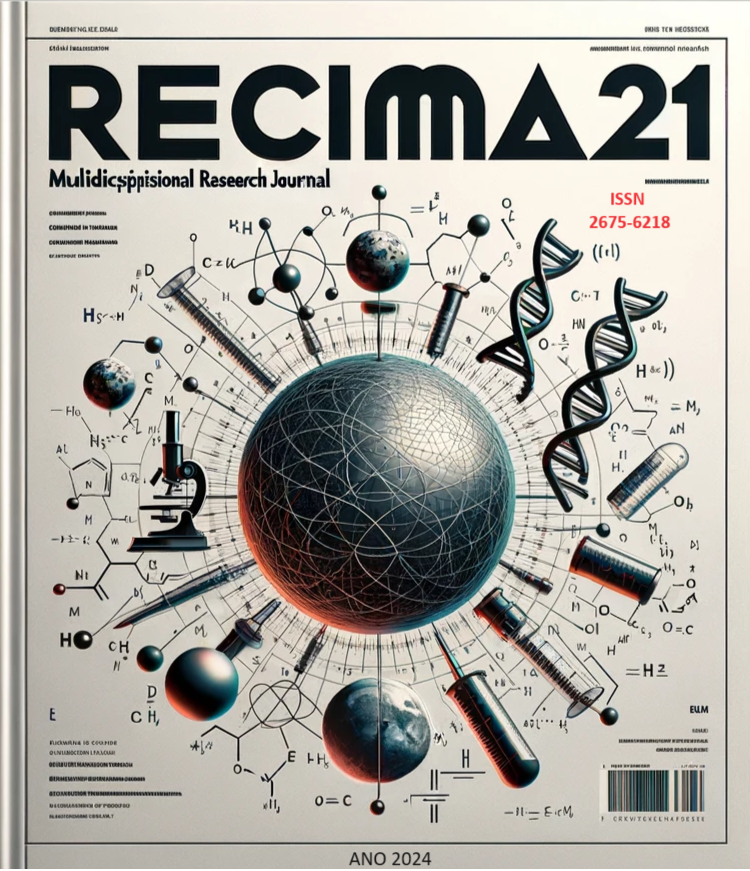REVERSIBILITY OF HYALURONIC ACID WITH HYALURONIDES
DOI:
https://doi.org/10.47820/recima21.v5i5.5255Keywords:
Reversibility of Hyaluronic Acid (HA). Action of the Enzyme Hyaluronidase. Applicability of HA in Clinical Situations.Abstract
The main objective of the article is to highlight the reversibility of hyaluronic acid (HA) in the face of hyaluronidase enzyme action, emphasizing its applicability in clinical settings even outside the laboratory environment. The variability in the behavior of HA across different commercial brands will be addressed, elucidating how this characteristic can influence its efficacy and safety in clinical contexts. Furthermore, previous studies will be reviewed to provide scientific grounding for the discussions presented.
Downloads
References
Monheit GD, Davis B. Nasolabial folds. In: Carru-thers J, Carruthers A, editors. Soft Tissue Augmentation. 2nd ed. Vol 99. Philadelphia, PA: Elsevier; 2008. p. 105-126.
Rizzatti-Barbosa CM, Meloto CB, Gomes SGE, Custodio W. Dental practice implications of systemic diseases affecting the elderly: a literature review. Braz J Oral Sci. 2008;1691-1699.
American Society of Plastic Surgeons [Internet]. 2012 plastic surgery procedural statistics. [Cited 2014 Jul 20]. Available from: http://www.plasticsurgery.org/news/plastic-surgery-statistics/2012-plastic-surgery-statistics.html.
Fagien S. Facial soft-tissue augmentation with injectable autologous and allogenic human tissue collagen matrix (autologen and dermalogen). Plast Reconstr Surg. 2000:105:362-73. DOI: https://doi.org/10.1097/00006534-200001000-00059
Romagnoli M, Belmontesi M. Hyaluronic acid-based fillers: theory and practice. Clin Dermatol. 2008;26(2):123-59. DOI: https://doi.org/10.1016/j.clindermatol.2007.09.001
Crocco EI, Alves RO, Alessi C. Eventos adversos do ácido hialurônico injetável. Surg Cosmet Dermatol 2012;4(3):259-63.
Park TH, Seo SW, Kim JK, Chang CH. Clinical experience with hyaluronic acid-filler complications. J Plast Reconstr Aesthet Surg. 2011;64(7):892-96. DOI: https://doi.org/10.1016/j.bjps.2011.01.008
Heydenrych I, Kapoor KM, De Boulle K, Goodman G, Swift A, Kumar N, Rahman E. Um plano de 10 pontos para evitar complicações relacionadas ao preenchimento dérmico de ácido hialurônico durante procedimentos estéticos faciais e algoritmos para gerenciamento. Clin. Cosmet. Investigue. Dermatol. 2018;11:603–611. doi: 10.2147/CCID.S180904. DOI: https://doi.org/10.2147/CCID.S180904
Bukhari SNA, Roswandi NL, Waqas M, Habib H, Hussain F, Khan S, Sohail M, Ramli NA, Thu HE, Hussain Z. Hyaluronic acid, a promising skin rejuvenating biomedicine: A review of recent updates and pre-clinical and clinical investigations on cosmetic and nutricosmetic effects. Int J Biol Macromol. 2018;120:1682-1695. DOI: https://doi.org/10.1016/j.ijbiomac.2018.09.188
Jung JM, Lee WS, Yoon J, Paik SH, Han HS, Lee WJ, Chang SE, Won CH, Kim BJ. A multicenter, randomized, double-blind comparison of two hyaluronic acid fillers in mid-face volume restoration in Asians: A 2-year extension study. Dermatol Ther. 2021;34(2):14787. DOI: https://doi.org/10.1111/dth.14787
Received 16 June 2020; accepted 20 October 2020
Trindade ARA, et al. Hyaluronidase in cosmiatry: what should we know?. Summary. 2015;7(3) DOI: https://doi.org/10.5935/scd1984-8773.20157301
Lee W, Oh W, Oh SM, Yang EJ. Comparative Effectiveness of Different Interventions of Perivascular Hyaluronidase. Plast Reconstr Surg. 2020;145(4):957-964.
Diwan Z, Trikha S, Etemad-Shahidi S, Virmani S, Denning C, Al-Mukhtar Y, et al. Case Series and Review on Managing Abscesses Secondary to Hyaluronic Acid Soft Tissue Fillers with Recommended Management Guidelines. J Clin Aesthet Dermatol. 2020;13(11):37-43.
Balasiano LKA, Bravo BSF. Hialuronidase: uma necessidade de todo dermatologista que aplica ácido hialurônico injetável. Surgical & Cosmetic Dermatology. 2014;6(4):338-43
Lee W, Oh W, Oh SM, Yang EJ. Comparative Effectiveness of Different Interventions of Perivascular Hyaluronidase. Plast Reconstr Surg. 2020;145(4):957-964. DOI: https://doi.org/10.1097/PRS.0000000000006639
Kim DW, Yoon ES, Ji YH, Park SH, Lee BI, Dhong ES. Vascular complications of hyaluronic acid fillers and the role of hyaluronidase inmanagement. Journal of Plastic, Reconstructive and Aesthetic Surgery. 2011;64(12):1590-1595. DOI: https://doi.org/10.1016/j.bjps.2011.07.013
Ryu C, Lu JE, Resposta de doze géis de ácido hialurônico diferentes a doses variadas de hialuronidase humana recombinante. Zhang-Nunes S. J Plast Reconstr Aesthet Surg. 2021 abril;74(4):881-889. doi: 10.1016/j.bjps.2020.10.051. Epub 2020, DOI: https://doi.org/10.1016/j.bjps.2020.10.051
Flynn TC, Thompson DH, Seok-Hee. Molecular Weight Analyses and Enzymatic Degradation Profiles of the Soft-Tissue Fillers Belotero Balance, Restylane, and Juvéderm Ultra.Plastic and reconstructive surgery. 2013;132:225-32S.
Flynn TC, Thompson DH, Seok-Hee. Molecular Weight Analyses and Enzymatic Degradation Profiles of the Soft-Tissue Fillers Belotero Balance, Restylane, and Juvéderm Ultra.Plastic and reconstructive surgery. 2013;132:225-32S. Doi: 10.1097/PRS.001331829e88a3. DOI: https://doi.org/10.1097/PRS.0b013e31829e88a3
Downloads
Published
How to Cite
License
Copyright (c) 2024 RECIMA21 - Revista Científica Multidisciplinar - ISSN 2675-6218

This work is licensed under a Creative Commons Attribution 4.0 International License.
Os direitos autorais dos artigos/resenhas/TCCs publicados pertecem à revista RECIMA21, e seguem o padrão Creative Commons (CC BY 4.0), permitindo a cópia ou reprodução, desde que cite a fonte e respeite os direitos dos autores e contenham menção aos mesmos nos créditos. Toda e qualquer obra publicada na revista, seu conteúdo é de responsabilidade dos autores, cabendo a RECIMA21 apenas ser o veículo de divulgação, seguindo os padrões nacionais e internacionais de publicação.













